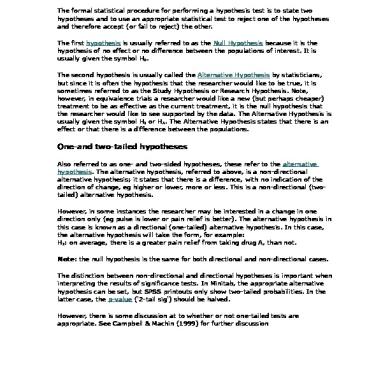Statistical Hypothesis Testing
This document was uploaded by user and they confirmed that they have the permission to share it. If you are author or own the copyright of this book, please report to us by using this DMCA report form. Report DMCA
Overview
Download & View Statistical Hypothesis Testing as PDF for free.
More details
- Words: 380
- Pages: 1
Statistical Hypothesis Testing The formal statistical procedure for performing a hypothesis test is to state two hypotheses and to use an appropriate statistical test to reject one of the hypotheses and therefore accept (or fail to reject) the other. The first hypothesis is usually referred to as the Null Hypothesis because it is the hypothesis of no effect or no difference between the populations of interest. It is usually given the symbol H0. The second hypothesis is usually called the Alternative Hypothesis by statisticians, but since it is often the hypothesis that the researcher would like to be true, it is sometimes referred to as the Study Hypothesis or Research Hypothesis. Note, however, in equivalence trials a researcher would like a new (but perhaps cheaper) treatment to be as effective as the current treatment, it is the null hypothesis that the researcher would like to see supported by the data. The Alternative Hypothesis is usually given the symbol H1 or HA. The Alternative Hypothesis states that there is an effect or that there is a difference between the populations.
One-and two-tailed hypotheses Also referred to as one- and two-sided hypotheses, these refer to the alternative hypothesis. The alternative hypothesis, referred to above, is a non-directional alternative hypothesis; it states that there is a difference, with no indication of the direction of change, eg higher or lower, more or less. This is a non-directional (twotailed) alternative hypothesis. However, in some instances the researcher may be interested in a change in one direction only (eg pulse is lower or pain relief is better). The alternative hypothesis in this case is known as a directional (one-tailed) alternative hypothesis. In this case, the alternative hypothesis will take the form, for example: H1: on average, there is a greater pain relief from taking drug A, than not. Note: the null hypothesis is the same for both directional and non-directional cases. The distinction between non-directional and directional hypotheses is important when interpreting the results of significance tests. In Minitab, the appropriate alternative hypothesis can be set, but SPSS printouts only show two-tailed probabilities. In the latter case, the p-value ('2-tail sig') should be halved. However, there is some discussion at to whether or not one-tailed tests are appropriate. See Campbell & Machin (1999) for further discussion
One-and two-tailed hypotheses Also referred to as one- and two-sided hypotheses, these refer to the alternative hypothesis. The alternative hypothesis, referred to above, is a non-directional alternative hypothesis; it states that there is a difference, with no indication of the direction of change, eg higher or lower, more or less. This is a non-directional (twotailed) alternative hypothesis. However, in some instances the researcher may be interested in a change in one direction only (eg pulse is lower or pain relief is better). The alternative hypothesis in this case is known as a directional (one-tailed) alternative hypothesis. In this case, the alternative hypothesis will take the form, for example: H1: on average, there is a greater pain relief from taking drug A, than not. Note: the null hypothesis is the same for both directional and non-directional cases. The distinction between non-directional and directional hypotheses is important when interpreting the results of significance tests. In Minitab, the appropriate alternative hypothesis can be set, but SPSS printouts only show two-tailed probabilities. In the latter case, the p-value ('2-tail sig') should be halved. However, there is some discussion at to whether or not one-tailed tests are appropriate. See Campbell & Machin (1999) for further discussion
Related Documents

Statistical Hypothesis Testing
April 2020 1
Hypothesis Testing
November 2019 32
Hypothesis Testing
May 2020 20
Hypothesis Testing
May 2020 25
Hypothesis Testing
June 2020 13